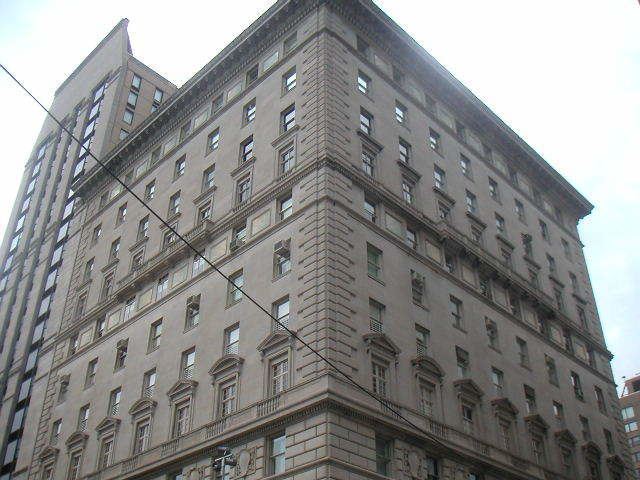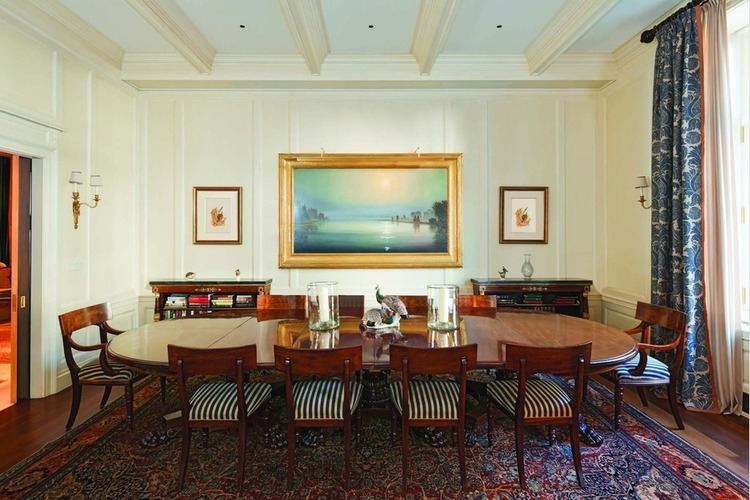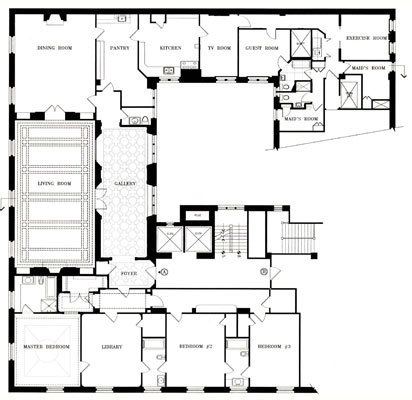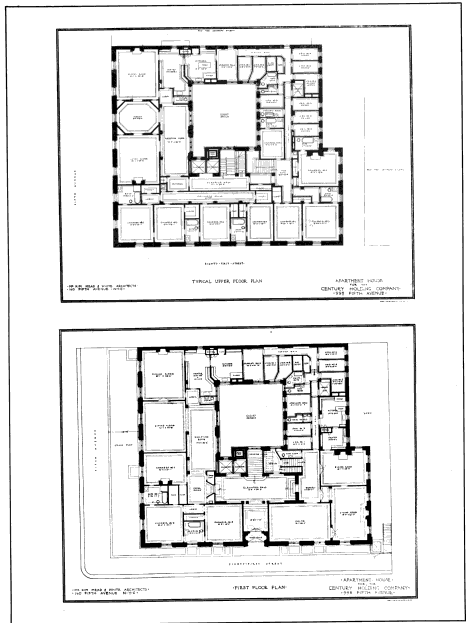 | ||
998 fifth avenue
998 Fifth Avenue is a luxury cooperative in Manhattan, New York and it is located on Fifth Avenue at the Northeast corner of East 81st Street on the Upper East Side.
Contents

Design

The 150-foot-tall (46 m), 12-story building was designed by the McKim, Mead & White architectural firm and built by James T. Lee (Jacqueline Kennedy Onassis’ grandfather) in 1910–1912. The Italian Renaissance-style Palazzo structure is sheathed entirely in limestone. It has a frontage of 102 feet 2 inches on Fifth Avenue and 115 feet (35 m) on the side street. Like most older apartment houses, it features a large cornice and an inner court 32.5 feet (9.9 m) square but no penthouses. Striking balustrade stringcourses define the division of the base from the body, and the body from the top. Each window above the stringcourse is capped with a pediment or cornice. Impressive panels of escutcheons and light-yellow marble adorn the structure horizontally at four-floor intervals. A heavily quoined corner and richly decorated overhanging eaves add to the exterior splendor of this structure. The imperial façade is further abetted with an iron marquee that extends over the side street entrance and is crested with palmette forms. The building has a large inner courtyard. There is a marquee on the side street entrance. The façade of 998 is divided into three horizontal sections to reduce the scale – a heavy base of rusticated stone, and then two midsections separated by ornamental plaques and balustrades. A cornice tops off the building. The exterior is notable for inset marble panels at the eighth and 12th floors, and the projecting iron and glass marquee over the main entrance. Built by the Harris H. Uris ironworks, the marquee (or, as it was more formally called in those days, the marquise) had a wire glass top and clear glass sides, allowing a flood of light into what was nominally an interior space.
Apartments

Although the original design called for 18 apartments, on its opening the building contained 15 units, as some of the upper floors were combined into exceptionally large "mansions in the sky". Floors 5 and 9 have ceiling heights of 11.5 feet, while the remaining have 10.5 feet. The ground floor has roughly 13 foot ceilings. The simplex maisonette on street level is 5250 SF, the duplex maisonette on the side street being exactly the same size. Floors 2-8 contain 7 simplexes, each 6250 SF with 15 rooms; these apartments contain 4 bedrooms, including a large corner master. On the side street floors 3-8 contain 3 duplex units, each 5000 SF. The upper 4 floors originally contained 3 apartments. The 9th and 10th floors each contain a single apartment roughly 8750 SF, with 2 more simplexes and a duplex on the last 2 floors. There are 2 main elevators for the tenants and 1 service elevator for the staff; also a service stair.
History

The building is well known as the first super-luxury apartment house on Fifth Avenue. The architect had been given carte blanche to create whatever was necessary to lure the very wealthy into the building. At the time of its construction, the upper class lived in mansions and townhouses on the Upper East Side. Grand apartments had been built before, but those were occupied by businessmen and the nouveau riche,not the upper crust of American society. During its construction, it was viewed as a remote and unpopular tower that invaded the city's best residential sections. When 998 Fifth Avenue was built the Metropolitan Museum of Art was much smaller and attracted far fewer people. Among the amenities the building had were wall safes, storage rooms in the basement and a large number of wood-burning fireplaces, as well as two-foot thick fireproof walls. Unlike the high-class apartment houses on the West Side, this building did not have a name. People simply mentioned 998 and one immediately knew they were talking about the most expensive and exclusive building in New York. The house was originally, like the vast majority of pre-war buildings a rental. The rents were astronomical compared to all the other buildings in the city. The largest units were leased for roughly $25000, while the smaller lower floor units for $10–12000. Among its first tenants were Elihu Root, Watson Bradley Dickerman, president of the New York Stock Exchange in the 1890s; George B. Fearing, a railroad investor and the president after 1916 of the Knickerbocker Club, a men's club at 62nd and Fifth; Levi P. Morton, vice president of the United States under Benjamin Harrison from 1889 to 1893 and later governor of New York in 1895 and 1896; Murry Guggenheim, a financier and mining operator who took the largest apartment; Victor Morawetz, Ludwig Dreyfus, Edson Bradley, E. Felsenheld, Thomas A.James, Lewis L.Clark and many other luminaries of the Gilded Age. Ultimately the building's broker, Douglas Elliman found over 100 prospects and 998 rented right away. In 1912 the magazine Architecture called it the most remarkable thing of its kind in America. Of course the fact that so many wealthy people rented apartments signaled the shift from the private houses to luxury buildings. That is why 998 is widely credited with convincing the upper class that apartments were suitable for living. The "servant problem" and the increasing time spent by the rich outside the city, the automobile and increasing taxes also favored this shift. In less than 20 years since the building's opening,over 90% of the wealthy people in New York lived in apartments. At the time of its opening in 1912, only 5% occupied apartments. The building was very famous because of its astronomical construction cost. The building cost roughly $3 million (including the land). To give an idea of what $3 million meant in 1912, the legendary liner RMS Titanic,which was built at about the same time as 998 cost $7.5 million.
Co-op and residents

998 Fifth Avenue is one of the most hard to penetrate pre-war buildings in NYC. It is one of the 4 best houses on the Avenue (alongside 820, 834 and 960 Fifth Avenue) and 10 best in the whole city. The apartments rarely are advertised and sell, depending on square footage or view, for $20 to 40 million. The building is one of the most storied on the "Gold Coast" and some of the best families in America have lived in its apartments. Astor, Guggenheim, Morton, Vanderbilt, Root and many other prominent families all were housed by this magnificent apartment house.
Overall

998 Fifth Avenue, one of the grandest, supreme apartment buildings in NYC is a masterpiece of the Gilded Age. Its palatial, mansion-sized units are some of the most sought-after apartments in the world. A very elegant masterpiece, it is considered by many real estate brokers a standout, a symbol of the Upper East Side and old money. It was converted to cooperative in 1953.
